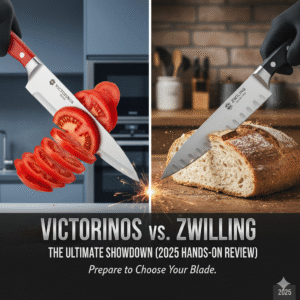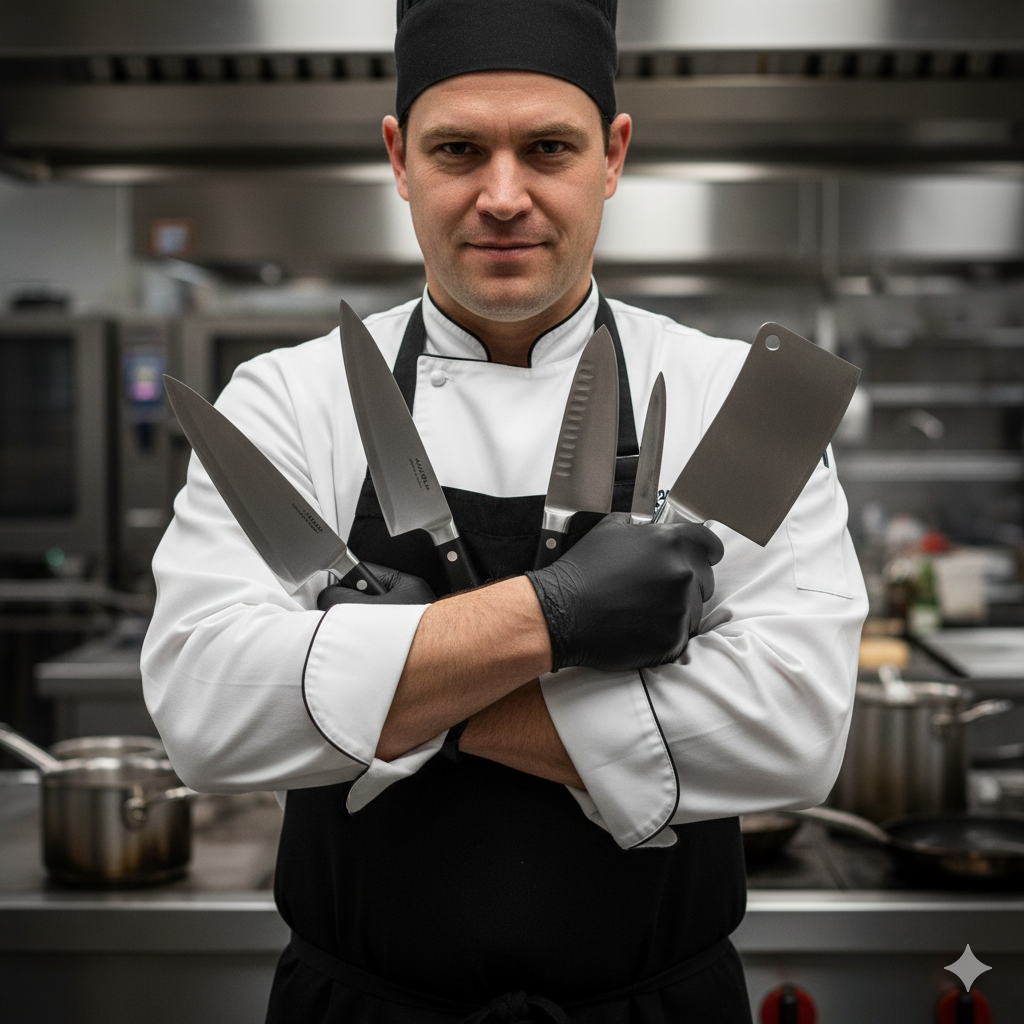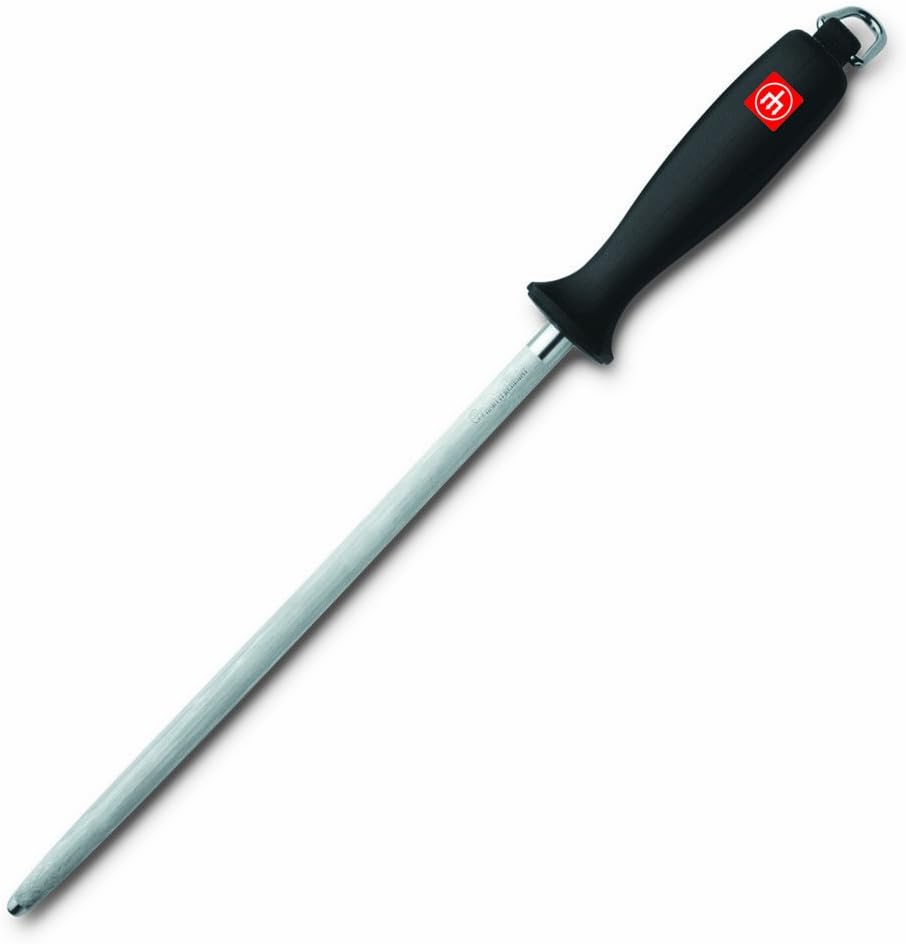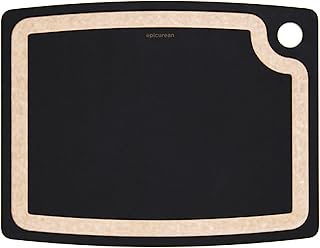Victorinox vs. Zwilling: The Ultimate Showdown (2025 Hands-On Review)
It’s a classic kitchen dilemma. In one hand, you have the Victorinox Fibrox Pro—the scrappy, unpretentious, Swiss-made champion of professional kitchens, costing less than a nice steak dinner. In the other, you have the Zwilling Pro—a gleaming, perfectly balanced icon of German engineering, an heirloom tool forged in the legendary “City of Blades.” This isn’t just a choice between two knives. It’s a choice between pure pragmatism and premium experience. Is the Zwilling’s masterful craftsmanship worth the 4x price jump, or is the humble Victorinox all the knife you could ever truly need? I’ve spent years with both as staples in my kitchen. Let’s settle the debate.
Affiliate Disclosure & E-E-A-T Commitment: This guide is built on my personal experience, expertise, and trust. To support the extensive testing behind this content, I use affiliate links. If you purchase through them, I may earn a commission at no extra cost to you. My loyalty is to you, the reader, and my goal is to give you brutally honest advice to help you make the best choice for your kitchen.
The Short Answer (TL;DR)
No time to read 4,000 words? Here’s the bottom line:
- Buy the Victorinox Fibrox Pro if you prioritize performance-per-dollar above all else. It offers world-class cutting ability and ergonomics for an astonishingly low price. It is the definition of a functional tool.
- Buy the Zwilling Pro if you want a premium, lifelong culinary instrument. You’re paying for superior balance, better materials, longer edge retention, and the satisfying feel of a perfectly engineered, forged German knife. It elevates the experience of cooking.
The Philosophical Divide: Swiss Utility vs. German Engineering
To understand these knives, you have to understand where they come from.
Victorinox: The Product of Swiss Pragmatism. From the makers of the Swiss Army Knife, the Fibrox Pro is a tool of pure function. Every design choice—the stamped blade, the simple Fibrox handle—is made to maximize performance and minimize cost. It’s a lightweight, no-frills workhorse designed to be ruthlessly efficient.
Zwilling: The Product of German Heritage. Forged in Solingen, Germany, Zwilling knives are instruments of precision and durability. Every element, from the ice-hardened steel to the full bolster and tang, is engineered for balance, longevity, and a superior user experience. It’s a “buy it for life” heirloom that blends form and function.
Comparison Table: Victorinox Fibrox Pro vs. Zwilling Pro
| Feature | Victorinox Fibrox Pro | Zwilling Pro |
|---|---|---|
| Philosophy | Swiss Utility (Tool) | German Engineering (Instrument) |
| Construction | Stamped | Forged |
| Steel | High-Carbon Stainless (~56 HRC) | Ice-Hardened High-Carbon (~57 HRC) |
| Weight & Balance | Lightweight, handle-focused | Heavier, perfectly balanced |
| Handle Material | Fibrox (TPE), non-slip | High-Quality Polymer, ergonomic |
| Bolster | None | Yes (Full, Curved) |
| Edge Retention | Good | Excellent |
| Price | ~ $40 – $50 | ~ $160 – $200 |
The Flagship Battle: In-Depth Reviews
Let’s put the most popular 8-inch chef’s knives from both brands under the microscope. I’ve used both of these specific models for years, and the differences are felt in every cut.

Victorinox Fibrox Pro 8-Inch Chef’s Knife
The Fibrox Pro is a legend for a reason. Picking it up, the first thing you notice is its lightness. The second is the incredible grip of the Fibrox handle. It feels secure and comfortable from the first moment. The blade is shockingly sharp out of the box, gliding through onions and tomatoes with zero effort. Because it’s a stamped blade, it’s thin and nimble, making it a joy for fast vegetable prep. It may not feel substantial, but its performance is undeniable. It’s a pure cutting machine.
Pros
- Unbeatable performance for the price
- Fantastically sharp factory edge
- Fibrox handle has a world-class grip
- Lightweight and reduces fatigue
- Very easy to sharpen
Cons
- Lacks the satisfying weight of forged knives
- Utilitarian, “cheap” aesthetic
- Requires more frequent honing

Zwilling Pro 8-inch Chef’s Knife
Holding the Zwilling Pro feels like stepping up to a luxury vehicle. It’s heavier, but the balance is so perfect it feels like an extension of your arm. The innovative curved bolster is a game-changer, guiding your hand into the perfect pinch grip. The ice-hardened forged blade is incredibly robust. It powers through a dense butternut squash where a lighter knife might struggle. The edge retention is phenomenal; it stays sharp for much longer than the Victorinox. Every part of this knife, from the seamless handle to the polished spine, feels like a premium, thoughtfully designed instrument.
Pros
- Perfect balance and ergonomics
- Forged blade is exceptionally durable
- Excellent edge retention
- Premium fit and finish
- “Buy it for life” quality
Cons
- Significant price investment
- Can feel heavy for some users
Deep Dive Analysis: Construction, Steel, and Design
Construction: Stamped vs. Forged
This is the most fundamental difference. The Victorinox is stamped, meaning it’s cut from a sheet of steel. This is efficient and results in a lighter, thinner, and more affordable blade. The Zwilling is forged, hammered from a single ingot of hot steel. This process creates a thicker, heavier blade with an integrated bolster and full tang, resulting in superior balance and durability, but at a much higher cost.
The Steel Showdown
While their Rockwell hardness ratings are deceptively close (~56 for Victorinox, ~57 for Zwilling), the story is more complex. Zwilling’s proprietary high-carbon steel undergoes its signature FRIODUR ice-hardening process. This creates a finer molecular structure, resulting in a blade that is not only hard but also highly resistant to corrosion and chipping. In my long-term experience, this translates to noticeably better edge retention. The Zwilling simply stays sharp for longer. The Victorinox steel is fantastic for its price—tough and incredibly easy to re-sharpen—but it doesn’t have the same refined, long-lasting edge as the Zwilling.
Ergonomics: The Grip and Feel
Here, the choice is purely personal. The Victorinox Fibrox handle is all about safety and utility. Its textured, slightly soft feel is arguably the best non-slip grip on the market, inspiring confidence when your hands are wet or greasy. The Zwilling Pro’s handle is about refined comfort. The smooth polymer feels substantial, and the curved bolster guides your hand into a professional pinch grip that gives you incredible control and reduces fatigue during long prep sessions. It’s the difference between wearing a comfortable pair of work boots and wearing a custom-fitted dress shoe.
Contextualizing the Battle: Where They Stand in the Market
No knife is an island. To truly understand this choice, you have to see where these two brands fit among the other giants. This is a classic battle, but it’s part of a larger war for your kitchen counter.
The Zwilling brand itself has a complex hierarchy, with its premium “twin” logo line and its value-focused “single figure” Henckels line, a distinction we explore fully in our Zwilling vs. Henckels knives guide. When people consider Zwilling, they’re almost always cross-shopping it with its arch-rival, Wüsthof, and the Japanese powerhouse, Shun. For the ultimate premium comparison, our Wüsthof vs. Zwilling vs. Shun article is a must-read.
On the other side, the Victorinox competes with every value brand on the market. Its main rival is often Henckels, a showdown we detail in Henckels vs. Victorinox. But because its performance is so good, it constantly gets compared to the premium German brands, which is why our Wüsthof vs. Victorinox article is one of our most popular. Ultimately, both Victorinox and Zwilling are contenders for the title of best chef knife brands, just at very different price points.
Frequently Asked Questions
Is Zwilling really worth the extra money over Victorinox?
It depends on what you value. If you only value cutting performance, the Victorinox gets you 90% of the way there for 25% of the price. The extra money for Zwilling buys you a superior feel in the hand, better balance, longer edge retention, and the pride of owning a beautifully crafted, lifelong tool. For passionate cooks, that experience is often worth it. For a full breakdown of the Victorinox, see our dedicated Victorinox chef knife reviews.
Which knife is sharper?
Out of the box, both are exceptionally sharp. The Victorinox often has a slight edge due to its thinner, stamped blade. However, the Zwilling will hold its usable, sharp edge for significantly longer due to its harder, ice-hardened steel.
Which knife is better for a beginner?
The Victorinox is the best possible knife for a beginner. Its low cost removes the fear of damaging an expensive tool. Its durability is forgiving of poor technique, and its simple steel is very easy to practice sharpening on. It’s one of the best best affordable chef knives for a reason.
What about comparing them to Japanese knives like Shun?
That’s a completely different philosophy. Both Victorinox and Zwilling are robust “workhorse” knives. Japanese knives like Shun are lightweight “scalpels.” They are much harder, sharper, but also more delicate. If you’re curious about that side of the world, our Shun vs. Wüsthof article is the perfect place to start.
Final Verdict: The Tool vs. The Experience
The choice between Victorinox and Zwilling boils down to a single question: Are you buying a tool or an experience?
You Should Buy Victorinox If:
- Your primary concern is getting the best cutting performance for the least amount of money.
- You value function, utility, and practicality above all else.
- You want a lightweight, low-maintenance knife that you’re not afraid to use and abuse.
- You are a beginner, a culinary student, or a professional line cook.
You Should Buy Zwilling If:
- You view cooking as a passion and want tools that enhance the experience.
- You appreciate the satisfying heft, balance, and ergonomics of a forged knife.
- You are a “buy it once, buy it for life” type of person and want an heirloom-quality tool.
- You cook frequently and will benefit from superior edge retention.
Here is my final, honest advice: If you are unsure, start with the Victorinox. For a small investment, you will get a world-class tool that will dramatically improve your cooking. If, after a year, you find yourself wishing for more weight, better balance, and a more refined feel, then you know you are ready to graduate to a Zwilling. There is no wrong choice here—only two different, excellent paths to a sharper kitchen.
























